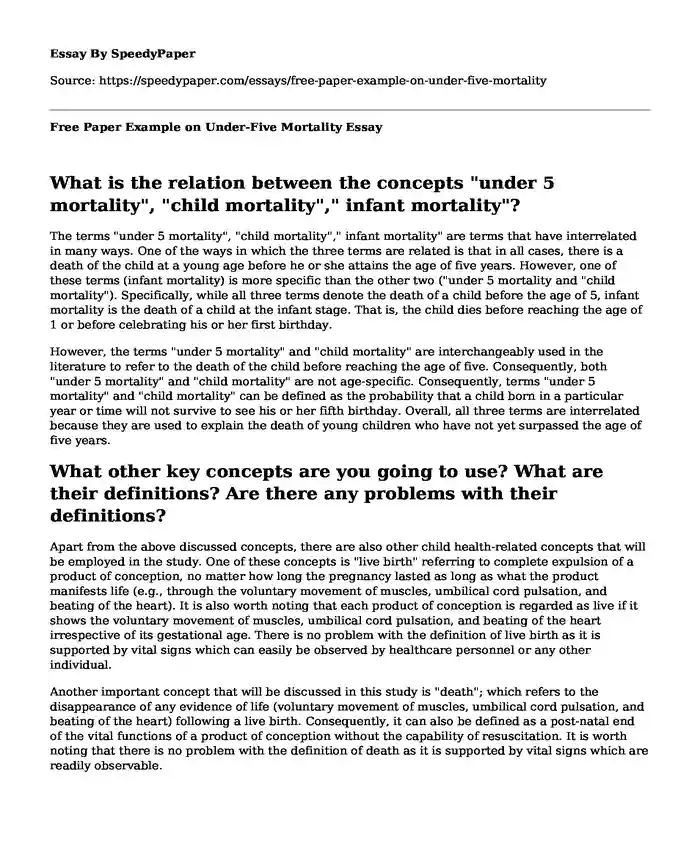
| Type of paper: | Questions & Answers |
| Categories: | Philosophy Ethics |
| Pages: | 2 |
| Wordcount: | 543 words |
What is the relation between the concepts "under 5 mortality", "child mortality"," infant mortality"?
The terms "under 5 mortality", "child mortality"," infant mortality" are terms that have interrelated in many ways. One of the ways in which the three terms are related is that in all cases, there is a death of the child at a young age before he or she attains the age of five years. However, one of these terms (infant mortality) is more specific than the other two ("under 5 mortality and "child mortality"). Specifically, while all three terms denote the death of a child before the age of 5, infant mortality is the death of a child at the infant stage. That is, the child dies before reaching the age of 1 or before celebrating his or her first birthday.
However, the terms "under 5 mortality" and "child mortality" are interchangeably used in the literature to refer to the death of the child before reaching the age of five. Consequently, both "under 5 mortality" and "child mortality" are not age-specific. Consequently, terms "under 5 mortality" and "child mortality" can be defined as the probability that a child born in a particular year or time will not survive to see his or her fifth birthday. Overall, all three terms are interrelated because they are used to explain the death of young children who have not yet surpassed the age of five years.
What other key concepts are you going to use? What are their definitions? Are there any problems with their definitions?
Apart from the above discussed concepts, there are also other child health-related concepts that will be employed in the study. One of these concepts is "live birth" referring to complete expulsion of a product of conception, no matter how long the pregnancy lasted as long as what the product manifests life (e.g., through the voluntary movement of muscles, umbilical cord pulsation, and beating of the heart). It is also worth noting that each product of conception is regarded as live if it shows the voluntary movement of muscles, umbilical cord pulsation, and beating of the heart irrespective of its gestational age. There is no problem with the definition of live birth as it is supported by vital signs which can easily be observed by healthcare personnel or any other individual.
Another important concept that will be discussed in this study is "death"; which refers to the disappearance of any evidence of life (voluntary movement of muscles, umbilical cord pulsation, and beating of the heart) following a live birth. Consequently, it can also be defined as a post-natal end of the vital functions of a product of conception without the capability of resuscitation. It is worth noting that there is no problem with the definition of death as it is supported by vital signs which are readily observable.
Is the current terminology univocal? Do all authors assign the same meaning to the individual key terms?
The terminologies discussed above are univocal as there are no multiple meanings associated with each of the terminologies. That is, all authors assign the same meaning to the individual key terms.
If not, what are you going to understand under the individual key terms in your work?
There are no multiple meanings associated with each of the terms discussed above.
Cite this page
Free Paper Example on Under-Five Mortality. (2023, Jan 24). Retrieved from https://speedypaper.net/essays/free-paper-example-on-under-five-mortality
Request Removal
If you are the original author of this essay and no longer wish to have it published on the SpeedyPaper website, please click below to request its removal:
Popular categories




